Module 5 Lao She Teahouse.新知讲解学案
文档属性
| 名称 | Module 5 Lao She Teahouse.新知讲解学案 | 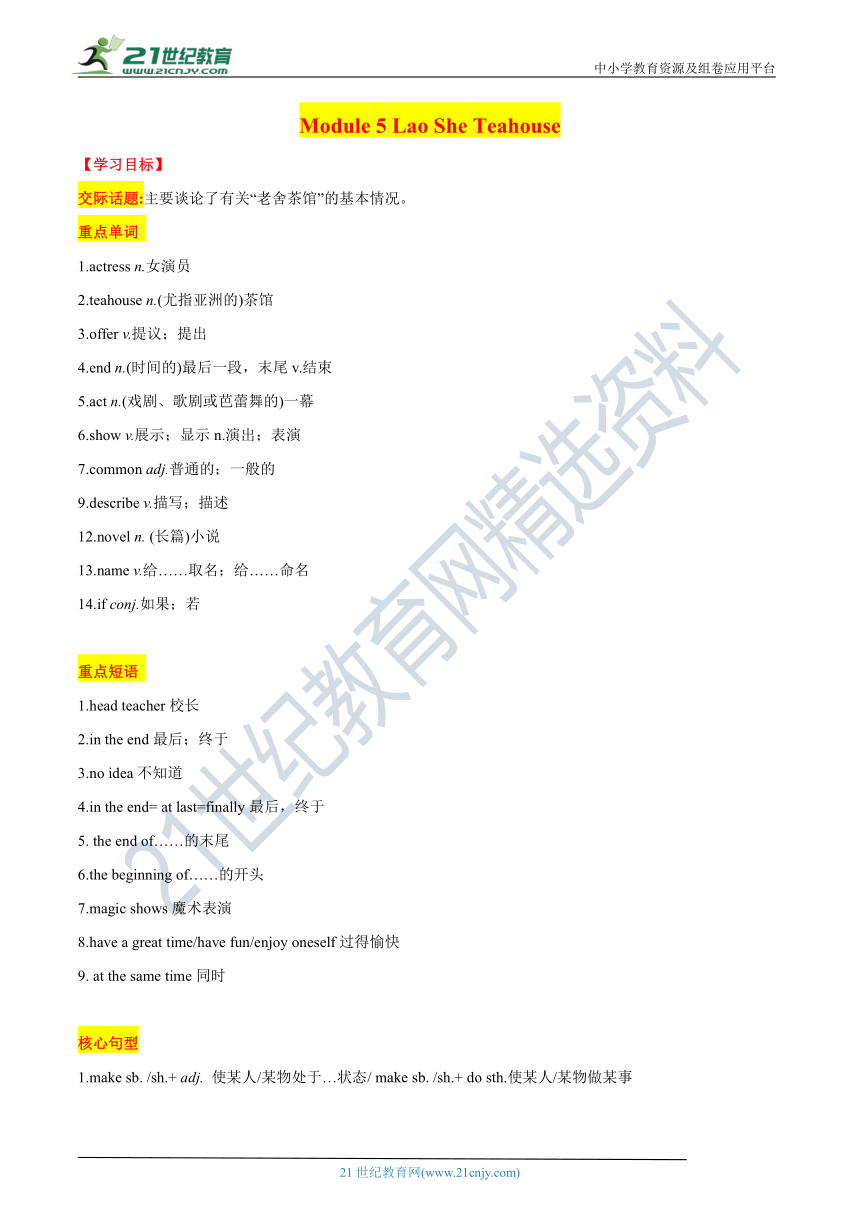 | |
| 格式 | doc | ||
| 文件大小 | 1.4MB | ||
| 资源类型 | 试卷 | ||
| 版本资源 | 外研版 | ||
| 科目 | 英语 | ||
| 更新时间 | 2021-08-13 10:22:55 | ||
图片预览

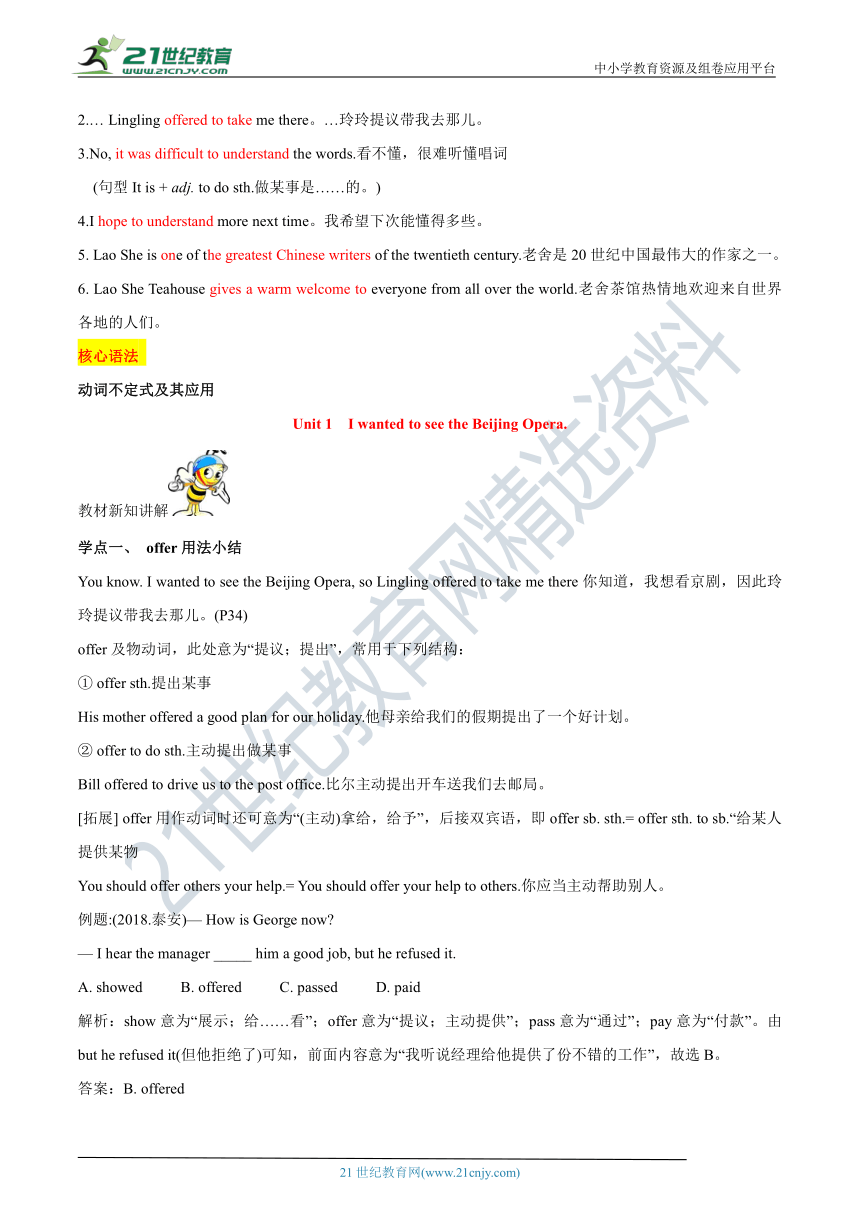
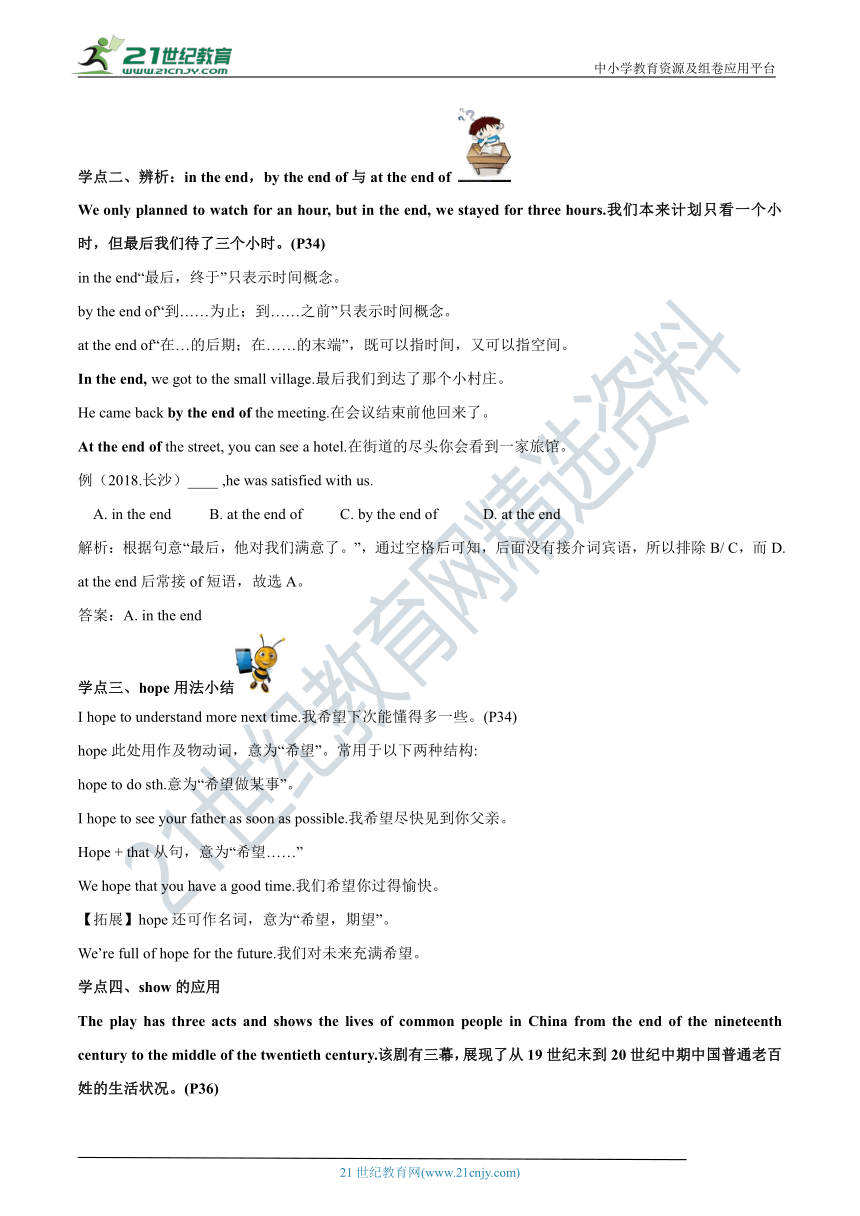
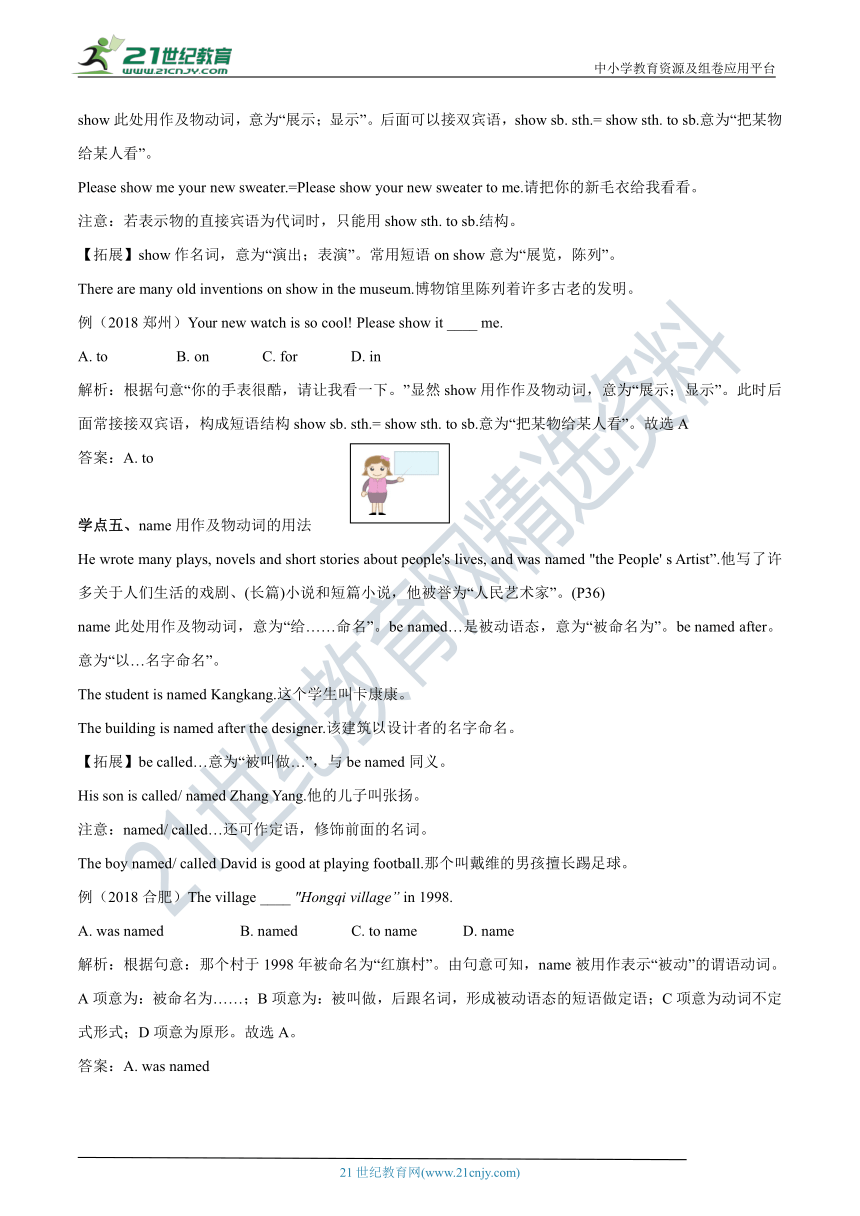
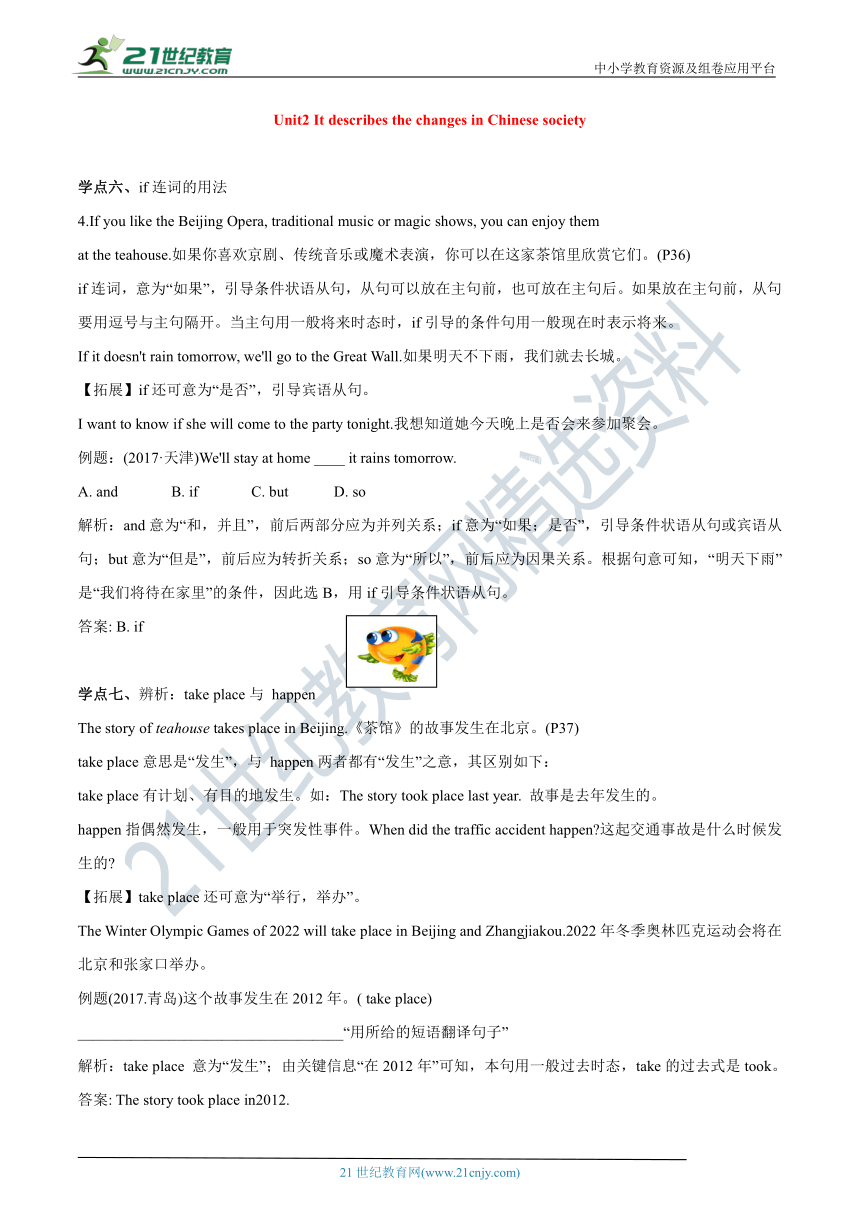
文档简介
中小学教育资源及组卷应用平台
Module 5 Lao She Teahouse
【学习目标】
交际话题:主要谈论了有关“老舍茶馆”的基本情况。
重点单词
1.actress n.女演员
2.teahouse n.(尤指亚洲的)茶馆
3.offer v.提议;提出
4.end n.(时间的)最后一段,末尾v.结束
5.act n.(戏剧、歌剧或芭蕾舞的)一幕
6.show v.展示;显示n.演出;表演
7.common adj.普通的;一般的
9.describe v.描写;描述
12.novel n. (长篇)小说
13.name v.给……取名;给……命名
14.if conj.如果;若
重点短语
1.head teacher校长
2.in the end最后;终于
3.no idea不知道
4.in the end= at last=finally最后,终于
5. the end of……的末尾
6.the beginning of……的开头
7.magic shows魔术表演
8.have a great time/have fun/enjoy oneself过得愉快
9. at the same time同时
核心句型
1.make sb. /sh.+ adj. 使某人/某物处于…状态/ make sb. /sh.+ do sth.使某人/某物做某事
2.… Lingling offered to take me there。…玲玲提议带我去那儿。
3.No, it was difficult to understand the words.看不懂,很难听懂唱词
(句型It is + adj. to do sth.做某事是……的。)
4.I hope to understand more next time。我希望下次能懂得多些。
5. Lao She is on_e_of_t_he greatest Chinese writers of the twentieth century.老舍是20世纪中国最伟大的作家之一。
6. Lao She T_eahous_e gives a warm welcome to everyone from all over the world.老舍茶馆热情地欢迎来自世界各地的人们。
核心语法
动词不定式及其应用
Unit 1 I wanted to see the Beijing Opera.
教材新知讲解
学点一、 offer用法小结
You know. I _wanted_ to see the Beijing Opera, so Lingling offered to take me there你知道,我想看京剧,因此玲玲提议带我去那儿。(P34)
offer及物动词,此处意为“提议;提出”,常用于下列结构:
① offer sth.提出某事
His mother offered a good plan for our holiday.他母亲给我们的假期提出了一个好计划。
② offer to do sth.主动提出做某事
Bill offered to drive us to the post office.比尔主动提出开车送我们去邮局。www.21-cn-jy.com
[拓展] of_fer??¨?????¨_词时还可意为“(主动)拿给,给予”,后接双宾语,即offer sb. sth.= offer sth. to sb.“给某人提供某物
You sho_uld_of_fer others your help.= You should offer your help to others.你应当主动帮助别人。
例题:(2018.泰安)— How is George now?
— I hear the manager _____ him a good job, but he refused it.
A. showed B. offered C. passed D. paid
解析:show意为_????±??¤??????????_…看”;offer意为“提议;主动提供”;pass意为“通过”;pay意为“付款”。由but he refused it(但他拒绝了)可知,前面内容意为“我听说经理给他提供了份不错的工作”,故选B。
答案:B. offered
学点二、辨析:in the end,by the end of与at the end of
We only plann_ed_to__watch for an hour, but in the end, we stayed for three hours.我们本来计划只看一个小时,但最后我们待了三个小时。(P34)【来源:21cnj*y.co*m】
in the end“最后,终于”只表示时间概念。
by the end of“到……为止;到……之前”只表示时间概念。
at the end of“在…的后期;在……的末端”,既可以指时间,又可以指空间。
In the end, we got to the small village.最后我们到达了那个小村庄。
He came back by the end of the meeting.在会议结束前他回来了。
At the end of the street, you can see a hotel.在街道的尽头你会看到一家旅馆。
例(2018.长沙)____ ,he was satisfied with us.
A. in _the_en_d B. at the end of C. by the end of D. at the end
解析:根据句意“最后,他对_??????????????????_”,通过空格后可知,后面没有接介词宾语,所以排除B/ C,而D. at the end后常接of短语,故选A。
答案:A. in the end
学点三、hope用法小结
I hope to understand more next time.我希望下次能懂得多一些。(P34)www-2-1-cnjy-com
hope此处用作及物动词,意为“希望”。常用于以下两种结构:
hope to do sth.意为“希望做某事”。
I hope to see your father as soon as possible.我希望尽快见到你父亲。
Hope + that从句,意为“希望……”
We hope that you have a good time.我们希望你过得愉快。
【拓展】hope还可作名词,意为“希望,期望”。
We’re full of hope for the future.我们对未来充满希望。
学点四、show的应用
The play has th_ree_ac_ts and shows the lives of common people in China from the end of the nineteenth century to the middle of the twentieth century.该剧有三幕,展现了从19世纪末到20世纪中期中国普通老百姓的生活状况。(P36)2·1·c·n·j·y
show此处用作及物动词,意_???????±??¤???????_示”。后面可以接双宾语,show sb. sth.= show sth. to sb.意为“把某物给某人看”。【出处:21教育名师】
Please show me__your__new sweater.=Please show your new sweater to me.请把你的新毛衣给我看看。
注意:若表示物的直接宾语为代词时,只能用show sth. to sb.结构。
【拓展】show作名词,意为“演出;表演”。常用短语on show意为“展览,陈列”。
There are many old inventions on show in the museum.博物馆里陈列着许多古老的发明。
例(2018郑州)Your new watch is so cool! Please show it ____ me. 【版权所有:21教育】
A. to B. on C. for D. in
解析:根据句意“你的手表很酷_???è?·è???????????_下。”显然show用作作及物动词,意为“展示;显示”。此时后面常接接双宾语,构成短语结构show sb. sth.= show sth. to sb.意为“把某物给某人看”。故选A
答案:A. to
学点五、name用作及物动词的用法
He wrote m_any_pl_ays, novels and short stories about people's lives, and was named "the People' s Artist”.他写了许多关于人们生活的戏剧、(长篇)小说和短篇小说,他被誉为“人民艺术家”。(P36)【来源:21·世纪·教育·网】
name此处用_???????????¨è?????_意为“给……命名”。be named…是被动语态,意为“被命名为”。be named after。意为“以…名字命名”。21·cn·jy·com
The student is named Kangkang.这个学生叫卡康康。
The building is named after the designer.该建筑以设计者的名字命名。
【拓展】be called…意为“被叫做…”,与be named同义。
His son is called/ named Zhang Yang.他的儿子叫张扬。
注意:named/ called…还可作定语,修饰前面的名词。
The boy nam_ed/_ca_lled David is good at playing football.那个叫戴维的男孩擅长踢足球。
例(2018合肥)The village ____ "Hongqi village” in 1998.21*cnjy*com
A. was named B. named C. to name D. name
解析:根据句意:_é???????????19_98年被命名为“红旗村”。由句意可知,name被用作表示“被动”的谓语动词。A项意为:被命名为……;B项意为:被叫做,后跟名词,形成被动语态的短语做定语;C项意为动词不定式形式;D项意为原形。故选A。
答案:A. was named
Unit2 It describes the changes in Chinese society
学点六、if连词的用法
4.If yo_u_like_ the Beijing Opera, traditional music or magic shows, you can enjoy them21教育名师原创作品
at the teahouse.如果你喜欢京剧、传统音乐或魔术表演,你可以在这家茶馆里欣赏它们。(P36)
if连词,意为“如果”,引导_?????????è????????_,从句可以放在主句前,也可放在主句后。如果放在主句前,从句要用逗号与主句隔开。当主句用一般将来时态时,if引导的条件句用一般现在时表示将来。
If it doesn_'t_rai_n tomorrow, we'll go to the Great Wall.如果明天不下雨,我们就去长城。
【拓展】if还可意为“是否”,引导宾语从句。
I want to know i_f_she__will come to the party tonight.我想知道她今天晚上是否会来参加聚会。
例题:(2017·天津)We'll stay at home ____ it rains tomorrow.21世纪教育网版权所有
A. and B. if C. but D. so
解析:and_??????????????????_且”,前后两部分应为并列关系;if意为“如果;是否”,引导条件状语从句或宾语从句;but意为“但是”,前后应为转折关系;so意为“所以”,前后应为因果关系。根据句意可知,“明天下雨”是“我们将待在家里”的条件,因此选B,用if引导条件状语从句。21cnjy.com
答案: B. if
学点七、辨析:take place与 happen
The story of teahouse takes place in Beijing.《茶馆》的故事发生在北京。(P37)
take place意思是“发生”,与 happen两者都有“发生”之意,其区别如下:
take place有计划、有目的地发生。如:The story took place last year. 故事是去年发生的。
happen指偶_???????????????è??_用于突发性事件。When did the traffic accident happen?这起交通事故是什么时候发生的?
【拓展】take place还可意为“举行,举办”。
The Winter O_lympic_ Games of 2022 will take place in Beijing and Zhangjiakou.2022年冬季奥林匹克运动会将在北京和张家口举办。
例题(2017.青岛)这个故事发生在2012年。( take place)
___________________________________“用所给的短语翻译句子”
解析:take place 意为“发生”;由关键信息“在2012年”可知,本句用一般过去时态,take的过去式是took。
答案: The story took place in2012.
学点八、使役动词let的用法
Let' s go next Saturday, Betty.让我们下周六去吧,贝蒂。(P38)
Let' s do s_th.?????????_让我们做某事吧”let是使役动词,常用于Let sb. do sh.句型。常见的使役动词有let,make和have。21教育网
Let' s go to school.让我们去上学吧。
He made me do my homework at once.他让我立刻做家庭作业。
I won't have you say such things.我不会允许你说这样的话。
例题:(2017.北京)Let's ____ for a walk, shall we?
A. to go B. going C. go D. gone
解析:Let' s do sth.意为“让我们做某事吧”,为固定句型。let是使役动词,其后用省略to的动词不定式作宾语补足语。故选C。21·世纪*教育网
答案: C. go。
学点九、数词hundred的用法
We learnt _a_lot__about people's lives in China some one hundred years ago.我们了解了很多约100年前中国人的生活。(P40)
hundred数词,意为“_??????????????????_具体数词时,hundred后不加-s,表示具体的数。 hundred前无具体数词时,用 hundreds of表示概数,意为“数以百计的”。
two hundred birds两百只鸟
hundreds of birds数百只鸟
【拓展】与 hundred用法类似的词还有thousand,million等。
There are two thousand students in my school.我们学校有两千名学生。
The old man has thousands of dollars.那位老人有数以千计的美元。
注意:hundred,thousand,million等词的用法:模糊数字两有(有s有of);具体数字两无(无s无of)。
例(2018.安阳)_____ people come to our village to visit every year.21*cnjy*com
A. Thousands B. Thousands of C. Thousand of D. Thousand
解析:thousand前有具_?????°è???????????_后不加-s,表示具体的数。thousand前无具体数词时,thousand表示大概数,意为“数以千计的”。故选B。
答案:B. Thousands of。
单元语法盘点
动词不定式及其应用
1.动词不定式的定义
动词不定式是一种非谓语动词形式,由“to+动词原形”构成,其中to不是介词,而是动词不定式符号。
2.动词不定式的类型
在句子中,动词不定式_?????¤?§??±???????_一是带to的动词不定式,即“to+动词原形”;二是省略to的动词不定式,即“动词原形”。动词不定式没有人称和数的变化,其否定结构为“not+ to+动词原形”或“not+动词原形”。
Tom wants to play table tennis after school.汤姆想放学后打乒乓球。(带to的动词不定式)
Mr. Wang' s joke made us laugh.王先生的笑话让我们大笑。(省略to的动词不定式)
They decided not to go swimming in the river.他们决定不去河里游泳。(动词不定式的否定结构)
注意:动词不定式后可接名词或介词结构,构成动词不定式短语。
to do the homework做家庭作业
to look at the pictures看这些图片
3.动词不定式(短语)的功能
动词不定式(短语)在句子中可以作主语、宾语、宾语补足语、表语、定语、状语等。本模块我们重点学习动词不定式作宾语的情况。
4.常见的接动词不定式作宾语的动词(短语)
①want, a_gree,__choose, decide, fail, hope, plan, offer, learn, would like等动词(短语) 后跟动词不定式作宾语。如:
We plan to go to Hong Kong tomorrow.我们计划明天去香港。
②ask, learn, show, teach, know等动词后可以用“疑问词+动词不定式”结构作宾语。如:
Can you teach me how to play basketball?你能教我怎样打篮球吗?
③like, love, begin, start等动词后既可以跟动词不定式作宾语,也可以跟动词的ing形式作宾语,意义差别不大。
I like singing, but I don't like to sing this song.我喜欢唱歌,但是我不喜欢唱这首歌。
forget,remember,try等动词后既可以跟动词不定式作宾语,也可以跟动词的ing形式作宾语,但是意义不同。
I forgot to close the windows.我忘了关窗。(没有关窗)
I forgot closing the windows.我忘记已关了窗。(已关了窗)
“find/think/feel+ it + adj.+动词不定式”结构中,it为形式宾语,后面的动词不定式(短语)为真正的宾语。
如:I find it easy to learn English well.我发现学好英语很容易。
例题(2018·西安)I w_anted__to see the Beijing Opera, so Lingling offered ____ me to watch an opera.
A .took B. takes C. to take D. taking
解析:offer to do sth.意为“主动提出做某事”,为固定搭配,故选C。
答案: C. to take
二双宾语
当要表达“给某人某物”时出现_?????¤?????¨??????_承受者,一个是物,一个是人,此时,我们采用下列表达方式:“动词+人+物”或“动词+物+介词+人”。其中人为间接宾语,物为直接宾语,这就是双宾语。
Please pass me the pencil.=Please pass the pencil to me.请把那支铅笔递给我。2-1-c-n-j-y
常跟双宾语的动词有give,show,pass,bring,lend,tell,teach,buy,send,make,cook等。
①当直接宾语是人称代词,或强_è°?é????????è?????_,常用“动词+物+介词+人”结构,根据动词的不同,介词有时用to,有时用for。由to引出间接宾语的动词有give,show,lend,tell等由for引出间接宾语的动词有buy,make,cok等。
②当间接宾语是代词,如it,them,则只能用“动词+it/ them+介词+人”这一结构。
例题:(2017·十堰)Miss Zhang teaches ____ English. She is very strict.
A. our B. we C. us D. ours
解析:teach sb_._sth._ 意为“教某人某事”,teach后接双宾语,English为直接宾语,人称代词作间接宾语,应用其宾格形式。句意:张老师教我们英语,她很严格。故选C。
答案: C. us
核心素养解读
老舍茶馆是以_è??è??_先生命名的茶馆,建于1988年,古香古色、京味十足。可以欣赏到_???è??_、_?????§_名流的精彩表演,同时品用名茶、宫廷细点和应季北京风味小吃。开业以来,老舍茶馆接待了很多中外名人,享有很高的声誉。来一起了解一下吧!
Lao?She_??Teaho_use?opened?in?1988.?Its?name?is after?the?famous?Chinese?writer?Lao.Lao?She?Teahouse,?visitors
sit in an _old??Be_ijing?setting,?and can drink?the?best?tea?in China.?They?watch?all?kinds?of?traditional?Chinese performance (表演)?art?and?enjoy?delicious?traditional?Beijing-style?snacks(小吃).?Since?it?opened, Lao?She
Teahouse?has?ent_ertain_ed(款待)many famous?people?from?China and?allover?the?world. The?teahouse?can?hold(容纳)upto250?guests at?once.?At?Lao?She Teahouse, there?are?opera?fans activities?from?2:30?to?5:?00?on Monday,
Wednesday a_nd??Fri_day?afternoons.?There?are?also?opera?and?folk music?performances?from?2:?30 to?5:?00?on
Tuesday and?_Thursd_ay?afternoons?of?each?week.?People?can enjoy performances of?Peking?Opera, folk?arts,
acrobatics and?magic?shows?from7:?40?to 9:?20?every evening.
To?get?there,?take?the?subway?to?Qianmen?Station.
_Tel:6302-1717_; 6303-6830; 6304-6334
1. How?many?people?can?Lao?She?Teahouse?hold?at?once?
A.1,500. B.250. C.400. D.500
2.?When?can?people?watch?opera?and?folk?music performances?
A.?On?Tuesday?afternoons. B.?On?Wednesday?afternoons
C.?On?Friday?afternoons. D.?On?Monday?afternoons.
3.?What?performances?can?people?watch?every evening?at?Lao?She?Teahouse?
A?Peking?Opera,?folk?arts,?pop?songs?and?magic?shows.
B.?Peking?Opera,?folk?arts,?acrobatics?and?magic?shows.
C. Pop?songs,?folk?arts,?acrobatics?and?magic?shows.
D.?Peking?Opera,?Western?music,?acrobatics?and magic?shows.
4.?How?does?the?writer?advise?us?to?go?to?Lao?She?Teahouse?
A. By plane. B. By train. C. By bus. D. By subway.
答案:1—5BABD
_21?????????è?????(www.21cnjy.com)_
Module 5 Lao She Teahouse
【学习目标】
交际话题:主要谈论了有关“老舍茶馆”的基本情况。
重点单词
1.actress n.女演员
2.teahouse n.(尤指亚洲的)茶馆
3.offer v.提议;提出
4.end n.(时间的)最后一段,末尾v.结束
5.act n.(戏剧、歌剧或芭蕾舞的)一幕
6.show v.展示;显示n.演出;表演
7.common adj.普通的;一般的
9.describe v.描写;描述
12.novel n. (长篇)小说
13.name v.给……取名;给……命名
14.if conj.如果;若
重点短语
1.head teacher校长
2.in the end最后;终于
3.no idea不知道
4.in the end= at last=finally最后,终于
5. the end of……的末尾
6.the beginning of……的开头
7.magic shows魔术表演
8.have a great time/have fun/enjoy oneself过得愉快
9. at the same time同时
核心句型
1.make sb. /sh.+ adj. 使某人/某物处于…状态/ make sb. /sh.+ do sth.使某人/某物做某事
2.… Lingling offered to take me there。…玲玲提议带我去那儿。
3.No, it was difficult to understand the words.看不懂,很难听懂唱词
(句型It is + adj. to do sth.做某事是……的。)
4.I hope to understand more next time。我希望下次能懂得多些。
5. Lao She is on_e_of_t_he greatest Chinese writers of the twentieth century.老舍是20世纪中国最伟大的作家之一。
6. Lao She T_eahous_e gives a warm welcome to everyone from all over the world.老舍茶馆热情地欢迎来自世界各地的人们。
核心语法
动词不定式及其应用
Unit 1 I wanted to see the Beijing Opera.
教材新知讲解
学点一、 offer用法小结
You know. I _wanted_ to see the Beijing Opera, so Lingling offered to take me there你知道,我想看京剧,因此玲玲提议带我去那儿。(P34)
offer及物动词,此处意为“提议;提出”,常用于下列结构:
① offer sth.提出某事
His mother offered a good plan for our holiday.他母亲给我们的假期提出了一个好计划。
② offer to do sth.主动提出做某事
Bill offered to drive us to the post office.比尔主动提出开车送我们去邮局。www.21-cn-jy.com
[拓展] of_fer??¨?????¨_词时还可意为“(主动)拿给,给予”,后接双宾语,即offer sb. sth.= offer sth. to sb.“给某人提供某物
You sho_uld_of_fer others your help.= You should offer your help to others.你应当主动帮助别人。
例题:(2018.泰安)— How is George now?
— I hear the manager _____ him a good job, but he refused it.
A. showed B. offered C. passed D. paid
解析:show意为_????±??¤??????????_…看”;offer意为“提议;主动提供”;pass意为“通过”;pay意为“付款”。由but he refused it(但他拒绝了)可知,前面内容意为“我听说经理给他提供了份不错的工作”,故选B。
答案:B. offered
学点二、辨析:in the end,by the end of与at the end of
We only plann_ed_to__watch for an hour, but in the end, we stayed for three hours.我们本来计划只看一个小时,但最后我们待了三个小时。(P34)【来源:21cnj*y.co*m】
in the end“最后,终于”只表示时间概念。
by the end of“到……为止;到……之前”只表示时间概念。
at the end of“在…的后期;在……的末端”,既可以指时间,又可以指空间。
In the end, we got to the small village.最后我们到达了那个小村庄。
He came back by the end of the meeting.在会议结束前他回来了。
At the end of the street, you can see a hotel.在街道的尽头你会看到一家旅馆。
例(2018.长沙)____ ,he was satisfied with us.
A. in _the_en_d B. at the end of C. by the end of D. at the end
解析:根据句意“最后,他对_??????????????????_”,通过空格后可知,后面没有接介词宾语,所以排除B/ C,而D. at the end后常接of短语,故选A。
答案:A. in the end
学点三、hope用法小结
I hope to understand more next time.我希望下次能懂得多一些。(P34)www-2-1-cnjy-com
hope此处用作及物动词,意为“希望”。常用于以下两种结构:
hope to do sth.意为“希望做某事”。
I hope to see your father as soon as possible.我希望尽快见到你父亲。
Hope + that从句,意为“希望……”
We hope that you have a good time.我们希望你过得愉快。
【拓展】hope还可作名词,意为“希望,期望”。
We’re full of hope for the future.我们对未来充满希望。
学点四、show的应用
The play has th_ree_ac_ts and shows the lives of common people in China from the end of the nineteenth century to the middle of the twentieth century.该剧有三幕,展现了从19世纪末到20世纪中期中国普通老百姓的生活状况。(P36)2·1·c·n·j·y
show此处用作及物动词,意_???????±??¤???????_示”。后面可以接双宾语,show sb. sth.= show sth. to sb.意为“把某物给某人看”。【出处:21教育名师】
Please show me__your__new sweater.=Please show your new sweater to me.请把你的新毛衣给我看看。
注意:若表示物的直接宾语为代词时,只能用show sth. to sb.结构。
【拓展】show作名词,意为“演出;表演”。常用短语on show意为“展览,陈列”。
There are many old inventions on show in the museum.博物馆里陈列着许多古老的发明。
例(2018郑州)Your new watch is so cool! Please show it ____ me. 【版权所有:21教育】
A. to B. on C. for D. in
解析:根据句意“你的手表很酷_???è?·è???????????_下。”显然show用作作及物动词,意为“展示;显示”。此时后面常接接双宾语,构成短语结构show sb. sth.= show sth. to sb.意为“把某物给某人看”。故选A
答案:A. to
学点五、name用作及物动词的用法
He wrote m_any_pl_ays, novels and short stories about people's lives, and was named "the People' s Artist”.他写了许多关于人们生活的戏剧、(长篇)小说和短篇小说,他被誉为“人民艺术家”。(P36)【来源:21·世纪·教育·网】
name此处用_???????????¨è?????_意为“给……命名”。be named…是被动语态,意为“被命名为”。be named after。意为“以…名字命名”。21·cn·jy·com
The student is named Kangkang.这个学生叫卡康康。
The building is named after the designer.该建筑以设计者的名字命名。
【拓展】be called…意为“被叫做…”,与be named同义。
His son is called/ named Zhang Yang.他的儿子叫张扬。
注意:named/ called…还可作定语,修饰前面的名词。
The boy nam_ed/_ca_lled David is good at playing football.那个叫戴维的男孩擅长踢足球。
例(2018合肥)The village ____ "Hongqi village” in 1998.21*cnjy*com
A. was named B. named C. to name D. name
解析:根据句意:_é???????????19_98年被命名为“红旗村”。由句意可知,name被用作表示“被动”的谓语动词。A项意为:被命名为……;B项意为:被叫做,后跟名词,形成被动语态的短语做定语;C项意为动词不定式形式;D项意为原形。故选A。
答案:A. was named
Unit2 It describes the changes in Chinese society
学点六、if连词的用法
4.If yo_u_like_ the Beijing Opera, traditional music or magic shows, you can enjoy them21教育名师原创作品
at the teahouse.如果你喜欢京剧、传统音乐或魔术表演,你可以在这家茶馆里欣赏它们。(P36)
if连词,意为“如果”,引导_?????????è????????_,从句可以放在主句前,也可放在主句后。如果放在主句前,从句要用逗号与主句隔开。当主句用一般将来时态时,if引导的条件句用一般现在时表示将来。
If it doesn_'t_rai_n tomorrow, we'll go to the Great Wall.如果明天不下雨,我们就去长城。
【拓展】if还可意为“是否”,引导宾语从句。
I want to know i_f_she__will come to the party tonight.我想知道她今天晚上是否会来参加聚会。
例题:(2017·天津)We'll stay at home ____ it rains tomorrow.21世纪教育网版权所有
A. and B. if C. but D. so
解析:and_??????????????????_且”,前后两部分应为并列关系;if意为“如果;是否”,引导条件状语从句或宾语从句;but意为“但是”,前后应为转折关系;so意为“所以”,前后应为因果关系。根据句意可知,“明天下雨”是“我们将待在家里”的条件,因此选B,用if引导条件状语从句。21cnjy.com
答案: B. if
学点七、辨析:take place与 happen
The story of teahouse takes place in Beijing.《茶馆》的故事发生在北京。(P37)
take place意思是“发生”,与 happen两者都有“发生”之意,其区别如下:
take place有计划、有目的地发生。如:The story took place last year. 故事是去年发生的。
happen指偶_???????????????è??_用于突发性事件。When did the traffic accident happen?这起交通事故是什么时候发生的?
【拓展】take place还可意为“举行,举办”。
The Winter O_lympic_ Games of 2022 will take place in Beijing and Zhangjiakou.2022年冬季奥林匹克运动会将在北京和张家口举办。
例题(2017.青岛)这个故事发生在2012年。( take place)
___________________________________“用所给的短语翻译句子”
解析:take place 意为“发生”;由关键信息“在2012年”可知,本句用一般过去时态,take的过去式是took。
答案: The story took place in2012.
学点八、使役动词let的用法
Let' s go next Saturday, Betty.让我们下周六去吧,贝蒂。(P38)
Let' s do s_th.?????????_让我们做某事吧”let是使役动词,常用于Let sb. do sh.句型。常见的使役动词有let,make和have。21教育网
Let' s go to school.让我们去上学吧。
He made me do my homework at once.他让我立刻做家庭作业。
I won't have you say such things.我不会允许你说这样的话。
例题:(2017.北京)Let's ____ for a walk, shall we?
A. to go B. going C. go D. gone
解析:Let' s do sth.意为“让我们做某事吧”,为固定句型。let是使役动词,其后用省略to的动词不定式作宾语补足语。故选C。21·世纪*教育网
答案: C. go。
学点九、数词hundred的用法
We learnt _a_lot__about people's lives in China some one hundred years ago.我们了解了很多约100年前中国人的生活。(P40)
hundred数词,意为“_??????????????????_具体数词时,hundred后不加-s,表示具体的数。 hundred前无具体数词时,用 hundreds of表示概数,意为“数以百计的”。
two hundred birds两百只鸟
hundreds of birds数百只鸟
【拓展】与 hundred用法类似的词还有thousand,million等。
There are two thousand students in my school.我们学校有两千名学生。
The old man has thousands of dollars.那位老人有数以千计的美元。
注意:hundred,thousand,million等词的用法:模糊数字两有(有s有of);具体数字两无(无s无of)。
例(2018.安阳)_____ people come to our village to visit every year.21*cnjy*com
A. Thousands B. Thousands of C. Thousand of D. Thousand
解析:thousand前有具_?????°è???????????_后不加-s,表示具体的数。thousand前无具体数词时,thousand表示大概数,意为“数以千计的”。故选B。
答案:B. Thousands of。
单元语法盘点
动词不定式及其应用
1.动词不定式的定义
动词不定式是一种非谓语动词形式,由“to+动词原形”构成,其中to不是介词,而是动词不定式符号。
2.动词不定式的类型
在句子中,动词不定式_?????¤?§??±???????_一是带to的动词不定式,即“to+动词原形”;二是省略to的动词不定式,即“动词原形”。动词不定式没有人称和数的变化,其否定结构为“not+ to+动词原形”或“not+动词原形”。
Tom wants to play table tennis after school.汤姆想放学后打乒乓球。(带to的动词不定式)
Mr. Wang' s joke made us laugh.王先生的笑话让我们大笑。(省略to的动词不定式)
They decided not to go swimming in the river.他们决定不去河里游泳。(动词不定式的否定结构)
注意:动词不定式后可接名词或介词结构,构成动词不定式短语。
to do the homework做家庭作业
to look at the pictures看这些图片
3.动词不定式(短语)的功能
动词不定式(短语)在句子中可以作主语、宾语、宾语补足语、表语、定语、状语等。本模块我们重点学习动词不定式作宾语的情况。
4.常见的接动词不定式作宾语的动词(短语)
①want, a_gree,__choose, decide, fail, hope, plan, offer, learn, would like等动词(短语) 后跟动词不定式作宾语。如:
We plan to go to Hong Kong tomorrow.我们计划明天去香港。
②ask, learn, show, teach, know等动词后可以用“疑问词+动词不定式”结构作宾语。如:
Can you teach me how to play basketball?你能教我怎样打篮球吗?
③like, love, begin, start等动词后既可以跟动词不定式作宾语,也可以跟动词的ing形式作宾语,意义差别不大。
I like singing, but I don't like to sing this song.我喜欢唱歌,但是我不喜欢唱这首歌。
forget,remember,try等动词后既可以跟动词不定式作宾语,也可以跟动词的ing形式作宾语,但是意义不同。
I forgot to close the windows.我忘了关窗。(没有关窗)
I forgot closing the windows.我忘记已关了窗。(已关了窗)
“find/think/feel+ it + adj.+动词不定式”结构中,it为形式宾语,后面的动词不定式(短语)为真正的宾语。
如:I find it easy to learn English well.我发现学好英语很容易。
例题(2018·西安)I w_anted__to see the Beijing Opera, so Lingling offered ____ me to watch an opera.
A .took B. takes C. to take D. taking
解析:offer to do sth.意为“主动提出做某事”,为固定搭配,故选C。
答案: C. to take
二双宾语
当要表达“给某人某物”时出现_?????¤?????¨??????_承受者,一个是物,一个是人,此时,我们采用下列表达方式:“动词+人+物”或“动词+物+介词+人”。其中人为间接宾语,物为直接宾语,这就是双宾语。
Please pass me the pencil.=Please pass the pencil to me.请把那支铅笔递给我。2-1-c-n-j-y
常跟双宾语的动词有give,show,pass,bring,lend,tell,teach,buy,send,make,cook等。
①当直接宾语是人称代词,或强_è°?é????????è?????_,常用“动词+物+介词+人”结构,根据动词的不同,介词有时用to,有时用for。由to引出间接宾语的动词有give,show,lend,tell等由for引出间接宾语的动词有buy,make,cok等。
②当间接宾语是代词,如it,them,则只能用“动词+it/ them+介词+人”这一结构。
例题:(2017·十堰)Miss Zhang teaches ____ English. She is very strict.
A. our B. we C. us D. ours
解析:teach sb_._sth._ 意为“教某人某事”,teach后接双宾语,English为直接宾语,人称代词作间接宾语,应用其宾格形式。句意:张老师教我们英语,她很严格。故选C。
答案: C. us
核心素养解读
老舍茶馆是以_è??è??_先生命名的茶馆,建于1988年,古香古色、京味十足。可以欣赏到_???è??_、_?????§_名流的精彩表演,同时品用名茶、宫廷细点和应季北京风味小吃。开业以来,老舍茶馆接待了很多中外名人,享有很高的声誉。来一起了解一下吧!
Lao?She_??Teaho_use?opened?in?1988.?Its?name?is after?the?famous?Chinese?writer?Lao.Lao?She?Teahouse,?visitors
sit in an _old??Be_ijing?setting,?and can drink?the?best?tea?in China.?They?watch?all?kinds?of?traditional?Chinese performance (表演)?art?and?enjoy?delicious?traditional?Beijing-style?snacks(小吃).?Since?it?opened, Lao?She
Teahouse?has?ent_ertain_ed(款待)many famous?people?from?China and?allover?the?world. The?teahouse?can?hold(容纳)upto250?guests at?once.?At?Lao?She Teahouse, there?are?opera?fans activities?from?2:30?to?5:?00?on Monday,
Wednesday a_nd??Fri_day?afternoons.?There?are?also?opera?and?folk music?performances?from?2:?30 to?5:?00?on
Tuesday and?_Thursd_ay?afternoons?of?each?week.?People?can enjoy performances of?Peking?Opera, folk?arts,
acrobatics and?magic?shows?from7:?40?to 9:?20?every evening.
To?get?there,?take?the?subway?to?Qianmen?Station.
_Tel:6302-1717_; 6303-6830; 6304-6334
1. How?many?people?can?Lao?She?Teahouse?hold?at?once?
A.1,500. B.250. C.400. D.500
2.?When?can?people?watch?opera?and?folk?music performances?
A.?On?Tuesday?afternoons. B.?On?Wednesday?afternoons
C.?On?Friday?afternoons. D.?On?Monday?afternoons.
3.?What?performances?can?people?watch?every evening?at?Lao?She?Teahouse?
A?Peking?Opera,?folk?arts,?pop?songs?and?magic?shows.
B.?Peking?Opera,?folk?arts,?acrobatics?and?magic?shows.
C. Pop?songs,?folk?arts,?acrobatics?and?magic?shows.
D.?Peking?Opera,?Western?music,?acrobatics?and magic?shows.
4.?How?does?the?writer?advise?us?to?go?to?Lao?She?Teahouse?
A. By plane. B. By train. C. By bus. D. By subway.
答案:1—5BABD
_21?????????è?????(www.21cnjy.com)_
同课章节目录
- Module 1 How to learn English
- Unit 1 Let's try to speak English as much as possi
- Unit 2 You should smile at her.
- Unit 3 Language in use .
- Module 2 My home town and my country
- Unit 1 It's taller than many other buildings.
- Unit 2 Cambridge is a beautiful city in the east o
- Unit 3 Language in use .
- Module 3 Sports.
- Unit 1 Nothing is more exciting than playing tenni
- Unit 2 This year we training more carefully.
- Unit 3 Language in use .
- Module 4 Planes, ships and trains .
- Unit 1 He lives the farthest from school.
- Unit 2 What is the best way to travel.
- Unit 3 Language in use .
- Module 5 Lao She Teahouse.
- Unit 1 I wanted to see the Beijing Opera.
- Unit 2 It descibes the changes in Chinese society.
- Unit 3 Language in use .
- Module 6 Animals in danger.
- Unit 1 It allows people to get closer to them .
- Unit 2 The WWF is working hard to save them all.
- Unit 3 Language in use .
- Revision module A
- Module 7 A famous story
- Unit 1 Alice was sitting with her sister by the ri
- Unit 2 She was thinking about her cat.
- Unit 3 Language in use .
- Module 8 Accidents
- Unit 1 While the car were changing to red, a car s
- Unit 2 I was trying to pick it up when it bite me
- Unit 3 Language in use .
- Module 9 Population
- Unit 1 The population of China is about 1.37 billi
- Unit 2 Arnwick was a city with 200,000 people.
- Unit 3 Language in use .
- Module 10 The weathe
- Unit 1 It might snow.
- Unit 2 The weather is fine all year round.
- Unit 3 Language in use .
- Module 11 Way of life
- Unit 1 In China ,we open a gift later.
- Unit 2 In England, you usually drink tea with milk
- Unit 3 Language in use .
- Module 12 Help
- Unit 1 What should we do before help arrives?
- Unit 2 Stay away from windows and heavy furniture.
- Unit 3 Language in use .
- Revision module B
